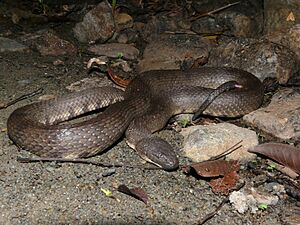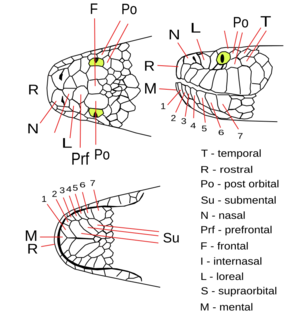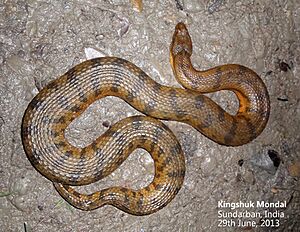New Guinea bockadam facts for kids
Quick facts for kids Cerberus rynchops |
|
|---|---|
 |
|
| Conservation status | |
| Scientific classification | |
| Genus: |
Cerberus
|
| Species: |
rynchops
|
| Synonyms | |
|
|
The Cerberus rynchops, also known as the dog-faced water snake, is a type of snake. It is mildly venomous. This snake lives in the coastal waters of South and Southeast Asia. It belongs to a family of snakes called Homalopsidae. In 2012, scientists studied this species again. They found that some populations, especially those east and south of Thailand, are actually different species.
Contents
Meet the Dog-Faced Water Snake!
This snake gets its name because its upper jaw is often visible. This makes its face look a bit like a dog's. Its head is long and stands out from its neck. The snake has small, round eyes. Its back is dark gray. It often has faint dark blotches and a dark line across its eyes. The belly is usually cream-colored. It has two rows of large, dark gray spots.
Where It Lives and What It Eats
The dog-faced water snake loves watery places. You can often find it in mangrove forests and on muddy flats. It also lives in streams, ponds, and tidal pools. Sometimes, it even burrows into the mud. This snake is active at night, which means it is nocturnal. It mainly eats fish. It is also known to eat eels.
Cool Moves and Family Life
This snake has some interesting ways of moving. When it's on land, it moves in a special way called sidewinding. This helps it move across slippery surfaces. In a BBC show called 'Life in Cold Blood', a dog-faced water snake was filmed using this technique to jump across a mudflat. Before this, scientists didn't think snakes could truly jump! This snake also has a tail that can grip things, called a prehensile tail. This suggests it might be able to climb mangrove trees.
The dog-faced water snake gives birth to live young. It doesn't lay eggs. A mother snake can have anywhere from 8 to 30 babies at a time. They can be born either in the water or on land.
Snake Personality
This snake is usually calm and gentle. It is also quite tough. Because of this, it has become popular with snake enthusiasts in the Philippines. People who like snakes enjoy keeping them as pets. Its bright yellow or orange belly, especially on females, also adds to its popularity. In the Philippines, especially in the Central Visayas area, people call this snake "tangkig".
Snake Skin and Scales
The scales on this snake are distinctly keeled. This means they have a ridge down the middle. Around the middle of its body, it has between 21 and 25 rows of scales. The scales on its belly, called ventrals, number from 132 to 160. The scales under its tail, called subcaudals, range from 49 to 72.
Where in the World It Lives
This snake can live in saltwater. It is found in several countries in Asia. These include India (and its Andaman and Nicobar Islands), Bangladesh, Myanmar, Thailand, and northwestern Malaysia. Scientists are still trying to figure out exactly where its home range ends in the east, especially where it meets another similar snake called Cerberus schneiderii.




